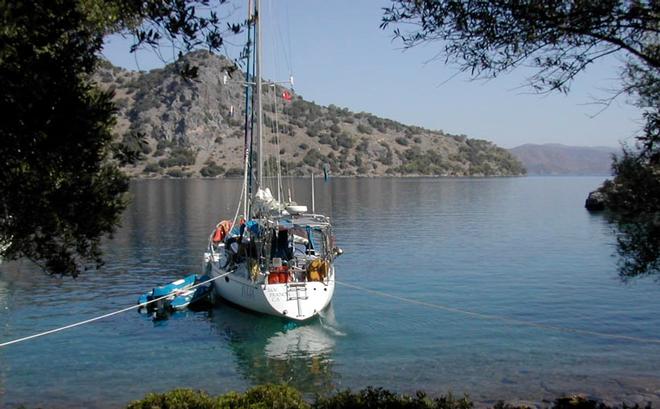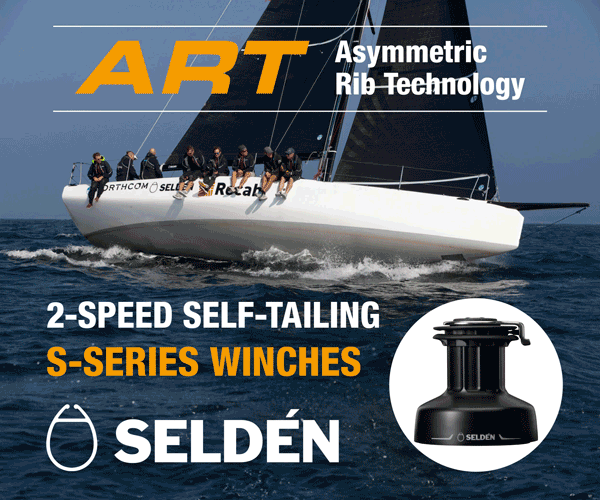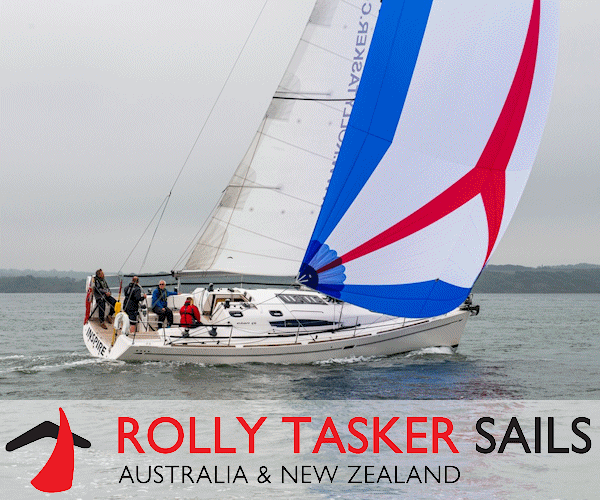How to anchor and 'never utter a word'
by Larry Jacobson on 19 Mar 2014

Julia at anchor SW


There are many articles published about anchoring for the cruising sailor, as well there should, because more boats are lost close to a coastline than ever in the middle of an ocean.
Here, cruising sailor, circumnavigator and successful author Larry Jacobson tells his own anchoring secrets, with engaging suggestions about hand signals which will 'stop the yelling' in an anchorage.
And the genesis of this advice? In Larry's words,
'Often people asked me how Ken and I were able to anchor without ever uttering a word and why we never dragged etc., so one day I sat down and wrote about it.' Here is what he wrote:
Much of what is taught about sailing is about how to make a boat go. I believe it is even more important to know how to make a boat stop and that means knowing how to anchor properly.
Like in a car, when the proverbial sh-t hits the fan (and it will), what is really most important, the gas pedal or the brakes? Thus, here are my top 12 tips for anchoring:
1. Scope is the ratio of your anchor rode to the depth. The more scope, the better. Unless it’s a crowded anchorage and everybody has set bow and stern anchors, remember that the chain doesn’t do any good sitting on the boat. My minimum scope ratio is five to one if I’m spending the night.
2. Watch your depth! Don’t forget to add the height of the bow roller from the water and to allow for the tide to come up to its maximum if you’re overnighting. Both can add up to a significant amount of 'depth' that needs to be incorporated in your calculations for scope.
3. Always back down on your anchor; engine slow at first to help it set, and then hard for at least a full minute. If you drag under reverse power, you’ll also drag when the wind pipes up.
4. Watch your bottom! If the bottom is grassy and has some sand patches, and you can see the sand, that’s where you drop the anchor. Don’t drop it purposely on the grass as anchors have a hard time digging through grass. Likewise, don’t drop it on coral or where it will drag onto coral. Speaking of coral, don’t even think of using rope if you’re anchoring anywhere near coral. It will slice through anchor rope like butter.
5. Stop the boat! The boat should be stopped, that means not moving forward when the anchor is dropped. In fact, it can already be drifting slowly back as long as your anchor is going to touch bottom where you planned. And don’t drop the chain so fast that it piles up. Ease it out as the boat backs.
6. Set an anchor alarm! Your onboard GPS has an anchor alarm built in—use it effectively by setting it to just under the amount you think you’ll swing. Use a 'manual alarm' by taking note of the bearings to at least two, if not three easily spotted landmarks onshore.
7. Note the nearest exit! If fog or a storm comes up, and it’s raining and blowing dogs off chains, which way out of the anchorage? Note the heading of your course out while the sun is up and the weather is good. Think ahead, not only about what the weather is, but what it could become.
8. Stop yelling! During six years of sailing around the world, we were often asked how we anchored with little fuss, no words, and certainly no yelling from wheel to bow or vice-versa. The secret is in hand signals. You can develop your own signals to communicate the following information:
a. Bow to helm: 'Stop the boat' (we used a clenched fist)
b. Helm to bow: 'Drop the anchor, boat is stopped' (we used a thumbs down)
c. Helm to bow: 'Let out xx feet' (we used 1 finger for each 30 feet of chain to let out and had our chain marked every 30 feet)
d. Bow to helm: 'Back down' (slow waving backwards of palm)
e. Bow to helm: 'Reverse power and back down hard' (fast waving backwards of palm)
f. Helm to bow: 'It’s set, let’s have a cocktail' (two fists together like airport people use)
g. Bow to helm: 'The anchor is that direction' (point with hand high enough for helmsman to see)
h. Bow to helm: 'Faster, slower, forward, reverse, port, starboard' (pointing with hand, and speed of hand movements)
i. Bow to helm: 'Anchor is free from the bottom' Give the Hawaiian 'Hang loose' shake of the hand with thumb and pinkie finger poking out of your fist. That means 'loose.' This is very important for the helmsman to know that the boat is no longer anchored and could be drifting somewhere undesirable!
j. Bow to helm: 'Anchor is at the waterline' when retrieving. This too is very important for the helmsman to know the boat can now be moved without fear of the anchor catching on a coral head or rock—we used a thumbs up for this.
k. Bow to helm: 'Anchor is on deck and chocked' (two fists together like the airport uses)
9. Go easy on your windlass! While the windlass may seem to be sturdy, its job is not to secure the anchor or take the load. Once the anchor is set, move the load to a bridle and cleats. (you can use a line tied to the chain with a rolling hitch) Similarly, when raising the anchor, use the boat’s movement over the anchor to break it free, not the windlass.
10. Have a spare anchor ready to go! Your anchor chain and connectors are sturdy but not infallible. We found this out more than once and were glad we had a spare bow anchor ready with its own set of chain.
11. Once the anchor is set, don’t hurry off of the boat. Relax, enjoy the view, and see how the boat sits, making sure you don’t swing into other boats, and be sure the anchor is set well. If the water is clear and warm, swim to the anchor to check that it’s set properly. Warning: do not do this where there are crocodiles!
12. Practice, practice, practice. There will come a time when you get one shot at dropping the anchor and you’ll want to do it right. There’s a hair-raising story about this in my book. Our practice definitely paid off! When you have built confidence in your anchoring ability, your cruising life will be all that much more relaxed and you’ll rest easier at night.
Happy Anchoring!
About Larry Jacobson:
A California native, circumnavigator and adventurer, Larry Jacobson grew up on the beaches of the Pacific Ocean sailing, kayaking, swimming, and scuba diving. A recognized expert in the corporate sales and marketing world, he was president of one of the premier incentive travel companies. An avid sailor, he has over 50,000 blue water miles to his name. Author of the award-winning best seller, 'The Boy Behind the Gate' (a great read, by the way), Larry is a motivational speaker and executive coach. He lives in the San Francisco Bay Area. He welcomes new friends and inquiries at: larry@larryjacobson.com
His website is: http://larryjacobson.com where you can purchase his book - the 'real thing' or for Kindle
Informative letter from reader:
Sender: Capt. Chris Dingle
Message: Too much line rode can wrap around a wing keel if and when the current is stronger against the boat than the wind. I have woken to find the boat sitting sideways to the rode and the anchor rode wrapped around the keel. Best then to snorkel under the boat and determine which way the line is wrapped. I have motored around it but always afraid of getting the rode in the prop. I have also used the sails to get unwrapped. Both means are difficult when in a packed anchorage or have an obstruction to maneuvering the boat. I have unwrapped the line by hand when the wind or current wasn't too strong. My point is that using too much rode can cause problems. All chain rode doesn't seem to get up to the keel and wrap. 5 to one scope is great for a lunch anchor when not leaving the boat. US SAILING teaches 5 to 1 for all chain and 7 to 1 for line. I always use 7 to 1 for overnight or leaving the boat at anchor. In a breeze I'll go up to 10 to 1.
Also often when current and wind are opposing I'll pull out 15% to 20% of the main sail to help keep the boat into the wind. Setting the helm hard over on either side can help to keep the boat from sailing around the anchor rode in current.
Rule on my boat is that no one speaks to the helm if outside the cockpit and then only in a calm quiet voice. Providing entertainment for those on the pier or in the anchorage is embarrassing and sound travels well over water. Same with docking or mooring. Set the plan with your crew in advance and demonstrate the hand signals every time.
If you want to link to this article then please use this URL: www.sail-world.com/120233